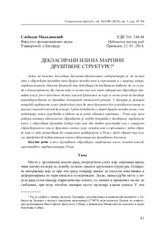Please use this identifier to cite or link to this item:
https://rfos.fon.bg.ac.rs/handle/123456789/1188Full metadata record
| DC Field | Value | Language |
|---|---|---|
| dc.creator | Miladinović, Slobodan | |
| dc.date.accessioned | 2023-05-12T10:43:34Z | - |
| dc.date.available | 2023-05-12T10:43:34Z | - |
| dc.date.issued | 2014 | |
| dc.identifier.issn | 0085-6320 | |
| dc.identifier.uri | https://rfos.fon.bg.ac.rs/handle/123456789/1188 | - |
| dc.description.abstract | Jedna od važnih posledica tehničko-tehnološke modernizacije je da veliki udeo u strukturi društva čine trajno nezaposleni i siromašni i, u krajnjoj liniji, marginalizovani. Njihova brojnost daje podsticaj da postavimo pitanje da li se radi o deklasiranima, tj. onima koji se nalaze van ili mimo oficijelne strukture društva ili je reč o posebnom obliku klasnog grupisanja za koji se može reči da postaje karakterističan za društva blokiranog ekonomskog razvoja. U teoriji je razvijen koncept marginalne klase (underclass) koji će ovom prilikom poslužiti kao okvir za analizu njihovog klasnog položaja. Treba dodati da se pored trajno nezaposlenih u ovu kategoriju može uvrstiti i gotovo cela jedna etnička zajednica - Romi koju neki autori nazivaju etnoklasom. Praktično je moguće govoriti o postojanju marginalne klase u strukturi društva Srbije koja ima dva bitno različita ali u socijalno strukturalnom smislu prilično slična sloja: nezaposlene i siromašne s jedne strane koji su ovde razvrstani po socijalnom kriterijumu i Rome s druge strane čiju klasnu pripadnost determiniše njihov etnosocijalni društveni položaj. | sr |
| dc.description.abstract | One of important consequence of technical and technological modernisation is that a large proportion of the structure of the society consists of permanently unemployed and poor and, ultimately, marginalized. Their number gives an incentive to raise the question of whether it is declassed, i.e. those who are outside or beyond the official structures of society or is it a special form of class grouping for which we may say that society is becoming characteristic of societies of blocked economic development. In theory, it was developed the concept of marginal class (underclass), which on this occasion will serve as a framework for the analysis of their class position. It should be added this term include not only unemployed but almost an entire ethnic group - the Roma people, which some authors call ethno-class. It is possible to speak of the existence of marginal class in the structure of society in Serbia, which has two very different but in terms of social structural layer quite similar strata: the unemployed and the poor on one side that are classified according to social criteria and Roma population on the other side of which class affiliations is determined by their ethnical social status. | en |
| dc.publisher | Sociološko društvo Srbije, Beograd | |
| dc.relation | info:eu-repo/grantAgreement/MESTD/Basic Research (BR or ON)/179074/RS// | |
| dc.rights | openAccess | |
| dc.rights.uri | https://creativecommons.org/licenses/by-sa/4.0/ | |
| dc.source | Sociološki pregled | |
| dc.subject | siromaštvo | sr |
| dc.subject | Romi | sr |
| dc.subject | nezaposlenost | sr |
| dc.subject | marginalna klasa | sr |
| dc.subject | marginalizacija | sr |
| dc.subject | klase | sr |
| dc.subject | društvene struktura | sr |
| dc.subject | the unemployment | en |
| dc.subject | the marginal class | en |
| dc.subject | social structure | en |
| dc.subject | Roma people | en |
| dc.subject | poverty | en |
| dc.subject | marginalization | en |
| dc.subject | class | en |
| dc.title | Deklasirani ili na margini društvene strukture? | sr |
| dc.title | Declassed or on the margins of social structure? | en |
| dc.type | article | |
| dc.rights.license | BY-SA | |
| dc.citation.epage | 68 | |
| dc.citation.issue | 1 | |
| dc.citation.other | 48(1): 47-68 | |
| dc.citation.rank | M24 | |
| dc.citation.spage | 47 | |
| dc.citation.volume | 48 | |
| dc.identifier.doi | 10.5937/socpreg1401047M | |
| dc.identifier.fulltext | http://prototype2.rcub.bg.ac.rs/bitstream/id/83/1184.pdf | |
| dc.identifier.rcub | conv_101 | |
| dc.type.version | publishedVersion | |
| item.cerifentitytype | Publications | - |
| item.fulltext | With Fulltext | - |
| item.grantfulltext | open | - |
| item.openairetype | article | - |
| item.openairecristype | http://purl.org/coar/resource_type/c_18cf | - |
| Appears in Collections: | Radovi istraživača / Researchers’ publications | |
This item is licensed under a Creative Commons License


